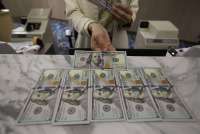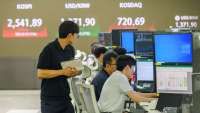INFLATION - WASHINGTON. The number of Americans filing new claims for unemployment benefits jumped to a 1-1/2-year high last week, pointing to widening cracks in the labor market, which together with subsiding inflation could allow the Federal Reserve to halt further interest rate increases next month.
Cooling price pressures were underscored by other data from the Labor Department on Thursday showing producer prices rebounding modestly in April, leading to the smallest annual increase in producer inflation in more than two years. The reports suggested that demand was slowing and raised the risks of a recession later this year.
"The Fed looks closer to winning the war on inflation today, but it risks losing the war on keeping the economy afloat and away from the shoals of recession," said Christopher Rupkey, chief economist at FWDBONDS in New York.
Initial claims for state unemployment benefits increased 22,000 to a seasonally adjusted 264,000 for the week ended May 6, the highest reading since October 2021. Economists polled by Reuters had forecast 245,000 claims for the latest week.
Though claims remain below the 270,000-300,000 level that economists said would signal a deterioration in the labor market, last week's increase could mark the start of an upward trend as the cumulative and lagged effects of the Fed's rate hikes broaden out in the economy.
"While the claims series can always be volatile from week to week, there are no obvious distortions to today's number," said Michael Feroli, chief U.S. economist at JPMorgan in New York.
"Business labor demand has been gradually cooling and today's initial claims reading hints at potentially a more abrupt slowing."
U.S. stocks opened lower. The dollar gained versus a basket of currencies. U.S. Treasury prices rose.
Read Also: China's Slow Consumer Inflation, Deepening Factory Gate Deflation to Test Policy
LABOR MARKET STILL TIGHT
Unadjusted claims increased 13,969 to 234,084 last week. There was a surge in applications in Massachusetts as well as significant increases in California, Missouri and New York. That offset notable declines in Colorado, Georgia and Kentucky.
The labor market remains tight, with 1.6 job openings for every unemployed person in March, well above the 1.0-1.2 range that is consistent with a jobs market that is not generating too much inflation. The Fed has raised its benchmark overnight interest rate by 500 basis points to the 5.00%-5.25% range since March 2022 and last week signaled it could pause its fastest monetary policy tightening campaign since the 1980s.
The number of people receiving benefits after an initial week of aid, a proxy for hiring, increased 12,000 to 1.813 million during the week ending April 29, the claims report showed. The so-called continuing claims remain low by historical standards as some of the laid-off workers are quickly finding employment.
In another report on Thursday, the Labor Department said the
producer price index for final demand rebounded 0.2% in April after dropping 0.4% in March. In the 12 months through April, the PPI increased 2.3%. That was the smallest year-on-year rise since January 2021 and followed a 2.7% advance in March.
Read Also: US Inflation Edges Higher on Rents, Gasoline But Some Relief Seen
A 0.3% increase in the cost of services accounted for 80% of the rise in the monthly PPI. Services where boosted by a 4.1% advance in portfolio management fees.
There were also increases in the costs of food and alcohol wholesaling, outpatient care, loan services as well as hospital inpatient care, hotel and motel rooms. But the cost of long-distance motor carrying fell as did food retailing and securities brokerage, dealing and investment advice.
Services prices dipped 0.1% in March. Goods prices rose 0.2% in April after declining 1.0% in March. They were driven by an 8.4% surge in gasoline prices. Food prices fell 0.5%.
Excluding the volatile food and energy components, core goods prices rose 0.2% after a similar gain in March.
The government reported on Wednesday that the annual increase in consumer prices slowed to below 5% in April for the first time in two years.
Excluding food, energy and trade services components, producer prices gained 0.2% in April after edging up 0.1% in March. In the 12 months through April, the core PPI rose 3.4% after increasing 3.7% in March.
"The PPI report reinforces the line of thinking that inflation can be brought back in line with policymakers' goals, but only by undermining consumer demand," said Kurt Rankin, a senior economist at PNC Financial in Pittsburgh, Pennsylvania.
/2021/06/03/1815443188p.jpg)












